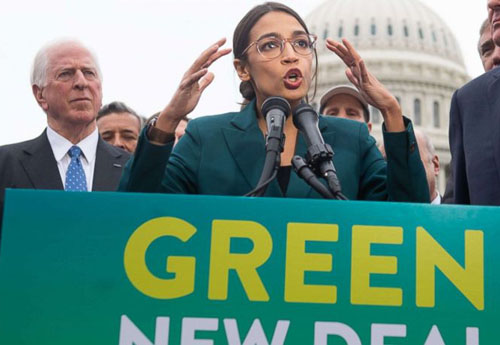by WorldTribune Staff, February 8, 2019
What exactly is the Green New Deal?
After a huge build-up and amid heavy media coverage, Rep. Alexandria Ocasio-Cortez on Feb. 7 unveiled her plan.

The Wall Street Journal’s Kimberly Strassel tweeted of the deal’s unveiling: “By the end of the Green New Deal resolution (and accompanying fact sheet) I was laughing so hard I nearly cried. If a bunch of GOPers plotted to forge a fake Democratic bill showing how bonkers the party is, they could not have done a better job. It is beautiful.”
Before the day was over, the New York Democrat’s staff would take down an online summary of the “Green New Deal” due to a series of gaffes, which included decommissioning all nuclear power plants, a reference to “farting cows” and guaranteed income for Americans who are “unwilling” to work.
Ocasio-Cortez’s office provided NPR the Green New Deal resolution and an accompanying FAQ document that described the plan’s goals, with a priority on moving America “to 100% clean and renewable energy” within 10 years.
“What immediately became clear, however, was that the legislative language didn’t match with Ocasio-Cortez’s FAQ, especially when it came to nuclear power, welfare programs and ‘farting cows,’ ” wrote Daily Caller Energy Editor Michael Bastasch.
The Green New Deal resolution does not have language ruling out nuclear or banning fossil fuels, but the accompanying FAQ actually did, Bastasch noted.
The FAQ document AOC’s staff gave to NPR reads: “A Green New Deal is a massive investment in renewable energy production and would not include creating new nuclear plants. It’s unclear if we will be able to decommission every nuclear plant within 10 years, but the plan is to transition off of nuclear and all fossil fuels as soon as possible.”
In its report, NPR noted that the “ultimate goal is to stop using fossil fuels entirely, Ocasio-Cortez’s office told NPR, as well as to transition away from nuclear energy.”
Jeremy Harrell, policy director at ClearPath, a conservative group that promotes low-emissions energy, told The Daily Caller that “Realistically, you can’t decommission a nuclear plant in ten years. She’s making false promises that aren’t even in the realm of the doable. She’s using this to push a liberal agenda.”
In a comprehensive study he co-authored on the feasibility of a 100 percent renewable grid in the United States, energy analyst Christopher Clack noted that completely decarbonizing the grid, including the use of nuclear power and carbon capture, would cost somewhere between $20 trillion and $40 trillion by 2050.
Before the entire FAQ was taken off of Ocasio-Cortez’s congressional website, the anti-nuclear language was removed and several other changes were made, Bastasch noted.
The FAQ also explained that the Green New Deal used the term “net-zero emissions, rather than zero emissions” because “we aren’t sure that we’ll be able to fully get rid of farting cows and airplanes that fast.”
The FAQ called for building “highspeed rail at a scale where air travel stops becoming necessary.”
Ocasio-Cortez’s staff eventually deleted “farting” from the FAQ, but not before reporters found it.
“Democrats were also hard-pressed to explain how Americans would phase out the internal combustion engine and what a world without air travel would look like,” Bastasch wrote.
Also included in Ocasio-Cortez’s FAQ was the promise of “[e]conomic security to all who are unable or unwilling to work,” which was also missing from the legislation.
The legislation does include the “goal to replace every combustion-engine vehicle.”
Sen. Ed Markey, Massachusetts Democrat and major supporter of the Green New Deal, told the Daily Caller that “The legislation calls for the elevation of all technologies which are technologically feasible. So, for example, the airline industry has already cut their greenhouse gases by 80 percent. They’re investing in new technologies. So, in that one instance, it would call for them to do what is technologically feasible. You know, as we’re moving forward.”
When asked what exactly he meant by “technologically feasible,” Markey replied, “That’s to be determined over the next 10 years. That’s what the legislation calls for.”
Sen. Mazie Hirono, Hawaii Democrat, was not too keen on the plan’s goal of replacing air travel with high speed rail.
“That would be pretty hard for Hawaii,” Hirono said.
Hawaii is roughly 2,500 miles away from Los Angeles, California, with a flight time of four and a half hours.
As NTK Network notes: “To put that in perspective, the longest railroad trip offered by Amtrak, which is not high-speed rail, is 2,265 miles from Chicago to Los Angeles and takes on average 43 hours to complete.”
Check Out Geostrategy-Direct __________ Jump Start the U.S. Media
